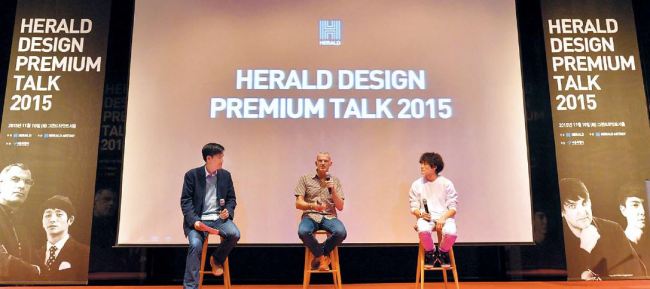‘Design for the sake of people, not objects’
Top designers discuss essence of good design in HDF Premium Talk
By 손지영Published : Nov. 11, 2015 - 17:47
“The world is about people, not objects,” according to industrial design expert Arik Levy. That philosophy fuels his belief that design should focus on improving people’s everyday lives in new ways.
“In the end, it’s only people that will help people,” said Levy, who opened a “Premium Talk” session held as part of the fifth Herald Design Forum in Seoul on Tuesday.
“In the end, it’s only people that will help people,” said Levy, who opened a “Premium Talk” session held as part of the fifth Herald Design Forum in Seoul on Tuesday.

As the Israeli-born, Paris-based designer believes design and creative endeavors are a “people-to-people” business, his human-oriented philosophy is reflected across his lighting, furniture and interior designs.
Levy, considered among the world’s leading industrial designers alongside Philippe Starck and Karim Rashid, for instance designed his versatile office furniture system “Work It for Vitra,” which enables a standard office setup in just about any space.
The system allows users to easily set up a wide range of office configurations with just a cube-shaped connecting element called “PIN” and a few additional parts, according to Levy.
“The molecule permits us to link the frame in any size and cut and fold the parts into different dimensions. Because every company works differently, they can tailor the variations to their needs.”
The designer also called upon designers to “look at things differently” in order to think of new ways of solving that problem. Such process requires “feeling before thinking” as well as identifying new orders and patterns in objects from differing industries, he said.
This year’s talks invited four design experts, including Levy, to lead two discussion sessions under the themes of “Creating Value through Design” and “Design Innovation,” respectively.
Kim Seol-jin, a South Korean creative director and contemporary dancer who won the second season of “Dancing 9” in 2014, emphasized the importance of “detailed observation” in creating the best designs for people.
“Observation is the key to designing something and anything for all living organisms, including people. By keenly observing, one can discover things that others cannot see,” Kim said.
In dance, for instance, performing the same movement in different spaces can give off an entirely different feel to spectators. “A simple up-and-down movement of the arms can significantly change depending on whether one is standing on land, in water or in mud as well as the strength and resistance of the arms,” according to Kim.
Spain-born food designer Marti Guixe, meanwhile, said he decided to pioneer a new field now known as food design in the mid-1990s -- an uncommon concept at the time -- in a move away from the traditional and narrow conception of design.
“I was very interested in mass production, including of food. I thought of food as a designable object that can be thought, contextualized, ritualized and consumed,” he said.
Some of his innovative food designs include a traditional Spanish dish made by taking out the inside of a tomato and putting bread inside, instead of under, as is traditionally done, as well as a pie-chart cake that represents how much of an ingredient was used by topping the cake with different-colored icing.
Other creative food design works by Guixe include a gin-and-tonic fog machine presented at an office opening party, inspired by the thought that “it’s important to drink a little to be more open,” and a hands-free lollipop that stands upright on three sticks.
Men’s fashion designer Kwon Mun-soo closed up the Tuesday talks by sharing his definition of a good design and designer -- one that can communicate and identify with the people.
“A good designer creates design -- anchored a clear and original philosophy -- which people can easily identify with. Especially in today’s world, I believe that people are drawn to things they can emphasize,” Kwon said.
By Sohn Ji-young (jys@heraldcorp.com)

















![[KH Explains] Hyundai's full hybrid edge to pay off amid slow transition to pure EVs](http://res.heraldm.com/phpwas/restmb_idxmake.php?idx=652&simg=/content/image/2024/04/18/20240418050645_0.jpg&u=20240418181020)

![[Today’s K-pop] Zico drops snippet of collaboration with Jennie](http://res.heraldm.com/phpwas/restmb_idxmake.php?idx=642&simg=/content/image/2024/04/18/20240418050702_0.jpg&u=)